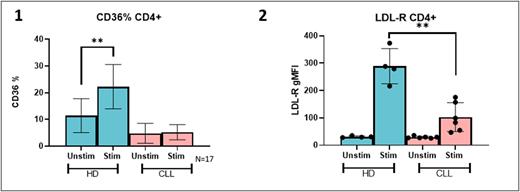Abstract
Background: Successful T cell-based anti-cancer therapies require proliferation and longevity of effector cells, features that highly depend on metabolic processes. A key feature of chronic lymphocytic leukemia (CLL) is acquired T cell dysfunction, resulting in impaired proliferative capacity (van Bruggen, et al Blood Adv 2022). T cell lipid metabolism has only recently come into focus as an important source of energy production and at the same time as essential component for the formation of new membranes upon proliferation. Fatty acid (FA) and lipid uptake in T cells requires several membrane proteins, among which the scavenger FA transporter CD36 and the low-density lipoprotein receptor (LDL-R). Specifically CD36-mediated FA transport has been identified to modulate (intratumoral) Treg and cytotoxic CD8+ T cells (Kolonin, et al, 2021 Immunometab). Whether T cell lipid and FA metabolism are affected in CLL is currently unknown.
Methods: Peripheral blood mononuclear cells (PBMCs) of untreated CLL patients and, as control, age-matched healthy donors (HD) were studied. T cells were analyzed by transcriptomics, lipidomics and flow cytometry, either directly after thawing or after a 2-day culture with or without αCD3/αCD28 antibodies.
Results: Unbiased transcriptomic analyses of patient-derived T cells following αCD3/αCD28 activation showed reduced expression of the master regulators of FA and cholesterol biosynthesis SREBF1 and SREBF2 in the presence of autologous CLL cells. This was associated with significantly reduced protein abundance of downstream targets of the SREBP pathway, including the key enzymes in FA synthesis and saturation FASN and SCD. In accordance with these data, lipidomic analyses highlighted an altered lipid profile in T cells from CLL patients that clearly demarcated them from HD T cells. In short, unbiased analyses revealed disturbed lipid homeostasis in CLL T cells at multiple levels, which led us to investigate lipid and FA metabolic pathways and their related functional consequences. Studying lipid and FA uptake capacity revealed lower expression of the FA transporter CD36 on CLL T cells. Stimulation of HD T cells resulted in upregulation of CD36 and the main receptor for cholesterol uptake LDL-R, accompanied by increased uptake of long chain fatty acids (LCFA) and increased FA-oxidation, concomitantly with induced expression of the activation marker CD25. In contrast, CLL-derived T cells did not increase CD36 or LDL-R expression, LCFA uptake or oxidation (Fig 1 and 2). Because of a recently suggested role for CD36 in T cell function, we next specifically analyzed CD36-expressing T cells (CD36+), and found these to have higher ability for LCFA and glucose uptake, and higher expression of the glucose transporter GLUT-1 than CD36 negative T cells from the same HD. Accordingly, CD36+ cells were also more likely to increase their CD25 expression and mitochondrial mass upon a 48h stimulation. This CD36+ T cell subpopulation, with potential metabolic and functional advantage, was virtually absent in CLL PBMCs. Impact of FA and lipid metabolism on proliferation was further established by the observation that culturing of HD T cells in absence of exogenous lipids resulted in nearly absent proliferative capacity. However, despite decreased expression of lipid and FA transporters, we observed marked accumulation of lipid droplets (LD) in T cells from CLL patients, suggesting an impaired ability to mobilize lipids towards oxidation pathways or as building blocks for membranes. In line with this, we found that in contrast to HD T cells that increased the expression of the rate-limiting enzyme for lipolysis ATGL, CLL T cells failed to do so.
Conclusions: We provide the first data showing a disturbed lipid and FA metabolism of CLL T cells that contributes to T cell dysfunction. This includes decreased expression of FA synthesis enzymes as well as FA and cholesterol transporters. CD36+ T cells are metabolically distinct and are largely absent in CLL. We are investigating strategies to increase FA and lipid metabolism in order to rebalance lipid homeostasis. This could ameliorate CLL T cell dysfunction and specifically proliferation defects in CLL.
Disclosures
Kater:Janssen, LAVA: Patents & Royalties: Pending; Abbvie, Astra Zeneca, Janssen: Other: Speakers fee; Abbvie, Astra Zeneca, BMS, Janssen, Roche/Genentech: Research Funding; Astra Zeneca, BMS, Roche/Gennetech, Janssen, Abbvie, LAVA: Membership on an entity's Board of Directors or advisory committees; Amsterdam UMC, University of Amsterdam: Current Employment.
Author notes
Asterisk with author names denotes non-ASH members.


This feature is available to Subscribers Only
Sign In or Create an Account Close Modal